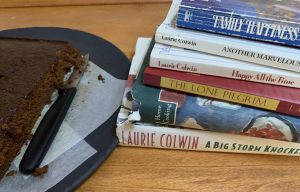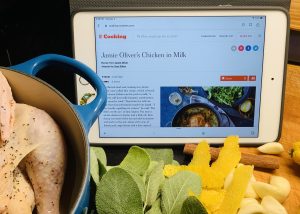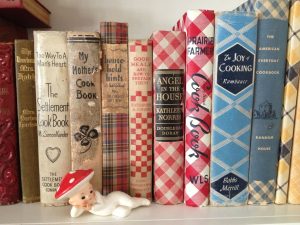By GAIL BLAKELY
A cookbook is a meticulously selected labor of love. Recipes are tested many times over and then they are copyedited by experts. Published recipes in cookbooks are generally reliable, keeping the sales of cookbooks flourishing. People still love to have, to hold, to display and to cook from actual physical cookbooks.
But what about the internet? Smartphones and e-reading devices were predicted to make print books obsolete. Interestingly, at the end of a long hard day (or at the beginning of a long-anticipated weekend to spend in the kitchen), many people find themselves not wanting to engage in the digital reading experience.

GAIL BLAKELY
Gingerbread from the cookbooks of Laurie Colwin
This desire for immersion in a physical book seems especially true for cookbooks, where the way in which books are put together, and the selection of recipes and photographs, is an experience that you cannot duplicate via the digital format. The lure of “unplugging” is tempting, which is why we still have hard-copy cookbooks on a kitchen shelf.
People ask why in the world would you bother with a cookbook in this day and age. Well, current wisdom says that just as television didn’t kill the radio, online recipes have not made cookbooks obsolete. In fact, it can be argued that cookbooks have actually become better since recipes are so plentiful online.
The Lisa Ekus group, a full-service culinary agency, works to support and connect culinary professionals across all platforms. Sally Ekus, culinary literary agent, believes that “cookbooks have more to offer than just recipes since anyone can get a recipe online. In many ways, they have become big, beautiful storybooks…collectors’ pieces to cook, and love, and imprint on.”
That’s because cookbooks have become books that are not just a collection of recipes, but rather books that contain a story, that evoke emotion, that can make you laugh, that might even provoke or challenge you to question things you didn’t think about before. This is a definite shift from cookbooks of just a decade ago.
One thing that cookbooks have always offered, and will always offer, is permanence—something that online recipes simply cannot provide. Physical cookbooks can be passed down from hand to hand, friend to friend, generation to generation. And this is something that feels important today, more than ever, as we try to preserve the importance of culture in our current world.
That said, let’s look at some of the differences between e-cookbooks and traditional cookbooks. Obviously, e-cookbooks can help save the planet, protecting our environment and reducing our carbon footprint. E-cookbooks are portable, lightweight and usually pretty affordable. You can store thousands of books on a single device, rather than adding more bookshelves to your home.

GAIL BLAKELY
Another way to cook
Another advantage is that they make reading accessible for everyone. They come with font style and size flexibility, a bonus for those who misplaced their reading glasses. Moreover, you can actually listen to your e-cookbook, as it is designed with text-to-speech or read-aloud features. So if you are too busy to read your e-cookbook, or if you are visually impaired or have a learning disability, this feature is an added prize.
Yet print books have the feel that many readers love. You can hold them, turn the pages, feel the paper and enjoy the illustrations. In fact, illustrations on paper are generally of higher quality than even high-end e-cookbooks can produce.
People who love to read spend much of their time acquiring books. Some may find it difficult to abandon their beloved bookshelves for a piece of plastic. Print books continue to be more expensive than e-books, but the price gap is closing.
However, your e-reader needs recharging, and some screens are not easily readable in sunlight. If you are one of the increasing number of people who spend their entire workday in front of a computer, reading on a tablet may not be very appealing at the end of the day.
E-readers are not essential, though. You can use your PC, your laptop or even your phone, as the reading app is simple to download. Paying for it may be another matter, certainly one to consider when deciding which way to read—and cook. E-readers range from about $90 to $300, depending on how many bells and whistles you prefer.
If you are going to use an e-cookbook in the kitchen, a slender e-reader is certainly preferable to a laptop. As someone once said, “Are you really going to put your laptop next to that skillet on a high flame?” Certainly something to consider.
 You can print hard-copy recipes from an e-cookbook, and your access to indexing is much faster than in a physical cookbook. On the other hand, printing your recipe involves paper, which brings us to trees and the environment. Have we come full circle here? Sometimes we just want to unplug (even if it is a temporary impulse), so having the option of a print cookbook is, at times, quite satisfying.
You can print hard-copy recipes from an e-cookbook, and your access to indexing is much faster than in a physical cookbook. On the other hand, printing your recipe involves paper, which brings us to trees and the environment. Have we come full circle here? Sometimes we just want to unplug (even if it is a temporary impulse), so having the option of a print cookbook is, at times, quite satisfying.
Print books offer a unique reading experience—e-books don’t engage the senses in the way a physical book does. You feel it, you smell it, you remember it—and when we are talking about food, this is one of the primary reasons that physical cookbooks are more popular. They really do touch readers on a more primal emotional level, which works especially well for those who enjoy cooking.
Finally, there is the issue of demographics. Print cookbook sales continue to do well, as they are, with notably few exceptions, given as gifts, especially by older cooks who may not be that familiar with the internet. Physical cookbooks might be considered the Cadillac of kitchen gifts—meaning that they have a demographic that is slowly aging out. However, purchasing a print cookbook in a local store goes a long way to supporting your local community, another plus that all cooks should consider.
In conclusion, just as reading is a very personal choice of activity, the method of reading is also subjective. Gifting a cookbook is a lovely idea; choosing which type of book to give is more complicated. Opening a brightly wrapped square is traditional; tearing open an envelope with a promise of an e-cookbook is less, but most likely equally, appreciated.
Don’t know which to choose? Print out a copy of the cover, place it in a box, wrap it up and tie it with a bow, and then say, “Which do you prefer?” You might be surprised by the answer—either way, you are gifting the promise of food-centered memories, a delicious present in itself.
Addendum
On a personal note, as a food writer and cooking instructor, I would estimate that about 50 percent of my cooking is done from recipes I have found on the internet and the rest is from my sizeable library of existing cookbooks. If I am using the internet, I am more apt to choose a recipe from a writer I trust, whose blog has proven reliable or whose cookbooks I have used in the past.
I was delighted to see that all of Laurie Colwin’s books have been reissued in matching editions: her two books about food and her three novels, as well as three story collections. Ms. Colwin died in 1992 and was a contributor to Gourmet magazine; she has a cultlike following for her food writing. The New York Times says she may be the only fiction writer in history who is known more for her recipes than her novels. Either way, her writing is as thought-provoking as it is delightful (“Alone in the Kitchen with an Eggplant” is a personal favorite). Her recipes are simple yet inspired—a fine choice for anyone who enjoys reading and cooking.
Laurie Colwin’s Gingerbread
4 ounces unsalted butter, additional for buttering pan
½ cup each: light or dark brown sugar and light molasses
2 large eggs
1½ cups AP flour
½ tsp baking soda
1½ TBSP ground ginger, or to taste
1 tsp cinnamon
¼ tsp each: ground cloves and allspice
2 tsp lemon brandy or vanilla extract
½ cup buttermilk (or milk with a little plain yogurt beaten into it)
Heat oven to 350 degrees Fahrenheit. Butter a 9-inch cake pan and set aside. Cream remaining 4 ounces of butter with the brown sugar; beat until fluffy, add molasses, then beat in eggs. Add flour, baking soda, ground ginger, cinnamon, cloves and allspice.
Add lemon brandy or vanilla extract and buttermilk and turn batter into pan.
Bake for 20 to 30 minutes (check after 20 minutes). Cool on a rack.

